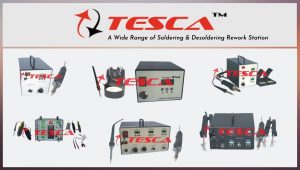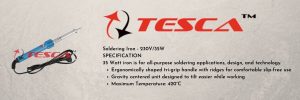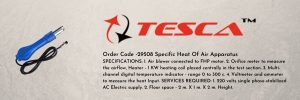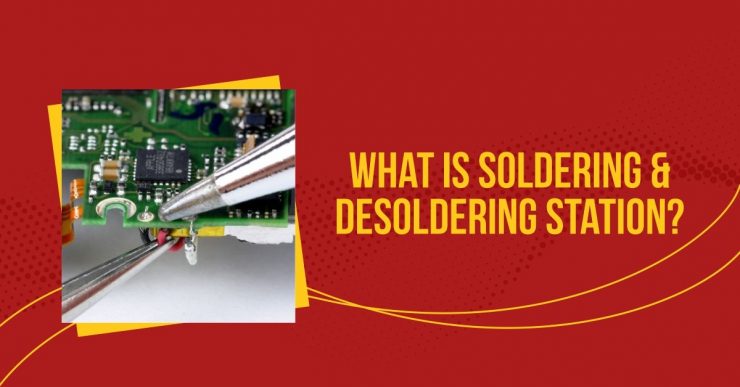Table of Contents
Soldering and Desoldering Rework Station:
With the electronic mechanisms becoming more advanced, complicated, and miniature, manual soldering tools are ineffective. This had led to widespread use of soldering and desoldering rework stations. They have become a vital component for manufacturing electronics.
Soldering and desoldering station are equipped with automatic techniques to perform any task with effectiveness. They can quickly assemble, repair, and troubleshoot any element of the board.
One can find the use of these stations in many industries, repair shops, and laboratories. This wide usage is due to its efficiency, various applications, and ability to perform complex electronic manufacturing.

Classification of Soldering Stations:
There is an extensive category of soldering and desoldering stations. They all depend on the temperature and material of components. They can be broadly classified as:
1. Contact Soldering Station:
Contact soldering station has a unit to adjust the electronic temperature. This unit is equipped with a soldering iron. The prime framework of this station is power.
The latest stations are equipped with 10 to 200 watts of power. The power determines the effectiveness of the soldering station. The higher power allows the transmission of a more significant amount of heat. The excess heat comes with the risk of overheating.
Hence, this category is further divided into subcategories such as lead soldering station and lead-free soldering station.
The difference in these two soldering stations is due to their varied temperature. For the lead-free soldering station, the temperature can reach up to 250 degrees Celsius. And on the other hand, a lead-based station needs only 180 degrees Celsius. The lead-free station heats much rapidly than the tin-lead soldering station.
2. Digital and Analogue Soldering Station:
Analog stations operate by balancing the temperature. The heating element keeps functioning as long as the soldering tip does not reach a particular temperature.
There is one limitation of this station that is it overheats the component. As this happens, the power turns off. When the temperature falls from this level, power again switches on to heat the element. The magnetoelectric relay with temperature sensors helps in operating this whole procedure.
Digital soldering station is more accurate than the analog method. It operates with the help of a PID regulator. A microprocessor controls this regulator and hence leads to the precision of the digital temperature control method.
3. Induction Soldering Station:
The induction soldering station is accompanied by high power and extraordinary thermal balance. The heating and thermal maintenance are done using Curie temperature.
4. Non-Contact Soldering Station:
The non-contact soldering station is divided into two subtypes:
A. Hot Air Soldering Station:
The hot air guns station comes into action when soldering iron alone fails to work effectively. For undoing the microchips, this soldering station is required. The hot air guns are equipped with nozzles that help in the easy flow of hot air streams.
Thus, SMD components generally use hot air guns for soldering. Thus, the system removes the older part of the board without any complications. It helps in saving the components of the board along with time.
B. Rework System:
The rework system has many beneficial components: a hot air gun, soldering iron, and desoldering gun. For laptops and other electronic repairs, this system is used. This method calls for certain automated functions and a unique approach. It provides the most effective soldering and desoldering of all the components.
Also Read: Fluke Test & Measurement Tools
Components of Soldering and Desoldering Stations:
The soldering tools are the determining factor of the capability and effectiveness provided by any soldering station. There are different components present in a station specialized to perform different functions. The main soldering station tools are as follows:
1. Soldering Irons:

The soldering iron is one of the main components of the soldering station. One set the temperature of the iron as per the solder alloy. It provides more excellent operation stability by indicating the temperature. The heating element stays isolated from the electricity network through that the user’s safety and protects the components from damage.
The soldering iron comes in a compact size. Moreover, many irons have auto turn on and off features. Hence operating them is effortless and user-friendly.
2. Desoldering Tools:
The PCB repair makes use of the desoldering process. It helps in unwinding some parts to check their working and condition. The desoldering iron disassembles the component from the board without altering any other parts.
In a soldering station, the following means are combined:
SMD hot tweezers melt down the solder alloy and detach the required part.
Desoldering iron solder the alloy by picking up the vacuum. It comes in the shape of a gun.
Non-contact healing tools assist in SMT disassembling. It comprises hot air and infrared heaters.
3. Hot Air Guns:

A hot air gun uses a hot air stream to raise the hotness of the element—the heated air emphasis on certain areas with the help of nozzles. The soldering hot air guns are capable of providing the temperature ranging 100 to 480 degrees Celsius.
4. Infrared Heaters:
The infrared soldering stations are a distinct type of soldering station and vary from all the other forms. It is highly used in electronic industries and provides more precision.
The temperature of solder depends upon its components. This decreases the risk of damage to the element due to varying temperatures.
Read More: 8085 Microprocessor Kit
How to use a Soldering Station?
The temperature generally depends on the element that needs to be soldered. For minute electronic components, a small range of temperature is sufficient. Secondly, the temperature also depends on the type of soldering station. One can achieve the fastest soldering with a high temperature.
Set the temperature to the lowest at the start of soldering and gradually increase the temperature after every minute. Continue doing so till the solder starts melting slowly.
Now at this point, increase the dial one step more, and you will reach the optimum temperature. It is sufficient to solder even the most sensitive components very effectively.
Safety Measures while Using Soldering Stations:
Soldering works requires extreme temperature and some toxic substances that can lead to a health issue. Therefore, it is essential to take precautionary steps before doing the soldering.
It is always best to look for all the warnings and safety measures that come with the station. Always read the instruction first about how to use the station to avoid any mishap. It is essential to wear safety glasses to protect the eye and keep all the sensitive material and tools away.
One should perform the soldering in a well-ventilated space. One can also use a fume extraction appliance as the fumes that are released are generally toxic. After performing the function, wash your hands and face properly.
Cleaning and Tinning of Soldering Station:
Keeping the tip of the soldering iron clean and tinned is necessary for its proper functioning. Any unwanted particular can reduce its efficiency. 2
Before soldering, clean the tip by rubbing the pad. If necessary, apply a re-activator. The tinning process comprises coating a layer on solder. It safeguards the tip from oxidizing and enhances the conductivity.
One should also keep cleaning the tip after every two to three hours of soldering. Keeping and maintaining the station increases its lifespan. Above all, it retains efficiency and satisfies users with adequate performance.
Advantages and Disadvantages of Soldering Station?
The soldering and desoldering stations are very beneficial. But at the same time, it also has some limitations. The advantages and disadvantages of this station are:
Advantages:
-
- The flexibility of the station is its highlight. It provides a soldering process and, at the same time, controls the temperature with accuracy.
- It can perform various tasks effortlessly.
- These stations are equipped with temperature sensor tips to control the heating of the soldering iron. And hence protect the element from damage.
- It reduces fatigue that user generally faces during manual soldering.
- This station decreases the rate of oxidation by maintaining the rising temperature.
- The soldering tip is durable and lasts longer.
- Their operation and maintenance are pretty straightforward, with minimum nozzles and buttons.
- The lock avoids the accidental operation of the soldering station and any mishap.
Disadvantages:
- The soldering station focuses on a particular spot that can lead to its overheating. If one does any carelessness, it can also lead to the damage of the component.
- On cooling, the solder gets harden. For soldering large objects, it creates quite a difficulty.
How to choose a Good Soldering Station?
Choosing an accurate and most effective soldering station is very important. A perfect soldering station is equipped with precise temperature control that can be either analog or digital.
The analog temperature control system has on-off control. When the heating element reaches a particular temperature, it turns off on its own. Though it costs less, it is also less efficient. Digital temperature control is more precise and better.
The efficient soldering station also has ESD protection. It comes with soldering iron tips that one can change accordingly. When choosing the soldering station, remembers to go with the one that reduces the fatigue for the operator.





Add comment